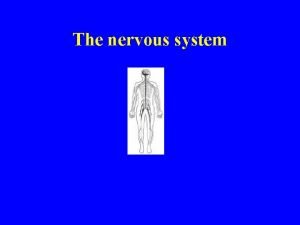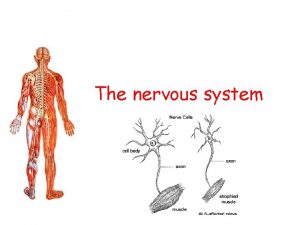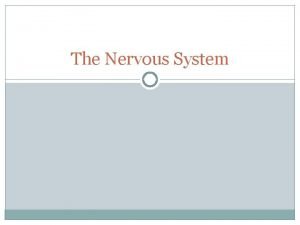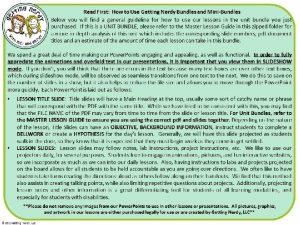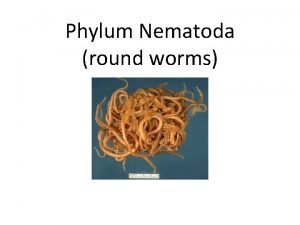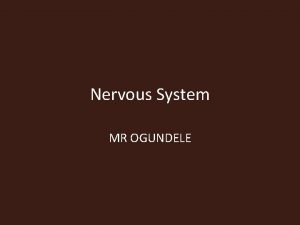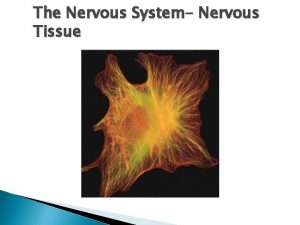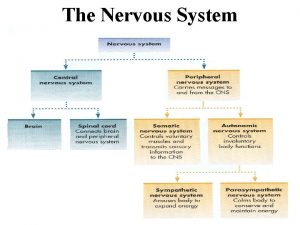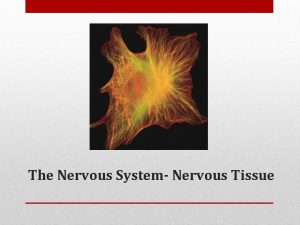The Nervous System The Nervous System What is
























- Slides: 24

The Nervous System

The Nervous System What is its FUNCTION? • Receives information about what’s happening inside and outside the body. • Directs the way your body responds to this info. • Helps maintain homeostasis.

The Nervous System (Central) The nervous system is made up of the: • Brain (controls most functions of the body) • Spinal Cord (a thick column of nerve tissue that links the brain to most of the nerves in the periphal nervous system) • Network of Nerves that

The Brain -About 3 pounds -Size of both hands together Interprets input from senses, controls the movement of skeletal muscles, and carries out mental processes such as learning, remembering, and making judgments. -2 halves (left and right) -Different parts of the brain do different things Brain Stemcontrols involuntary actions Cerebrum Cerebellumcoordinates actions of your muscles and helps yo keep your balance

A Neuron (Nerve Cell) AXON TIPS DENDRITES CELL BODY Neurons carry information through the nervous system. There are BILLIONS of neurons in your body. They are constantly sending/receiving messages.

A Neuron (Nerve Cell) AXON TIPS DENDRITES CELL BODY Direction message travels AXON – carries the messages down to the AXON TIPS, which sends the message to the next neuron. DENDRITES – receive messages and sends them toward CELL BODY.

Let’s act it out…. AXON TIPS DENDRITES CELL BODY What happens in your nervous system when you are stung by a bee?

The Nervous System & our Senses

Let’s test our Nervous systems…

Test Your Reaction Time How fast do messages travel in your nervous system? You will time how long it takes a message to travel from your EYES to your BRAIN to your HAND. Can we make the messages travel faster?

Test your Reaction Time May 5, 2009 Question: How long will it take for a nerve signal to travel from your EYES to your BRAIN to your HAND? Hypothesis: (Make a prediction!) Observations & Data Collection: (Paste your data table into your notebook) Conclusion Question: What happens to your reaction time as your practice? Explain. (Answer the question in your notebook).

Test Your Reaction Time 1) Hold your thumb and fingers about 3 cm apart at the 0 cm end of a meter stick. 2) Your partner will drop the meter stick and you need to grab it as quickly as possible. 3) The faster you grab it, the lower the measurement on the meter stick.

Test Your Reaction Time 4) Use the measurement on the meter stick to look up your reaction time in the table. 5) Repeat the experiment 3 -4 times. 6) What happens to your reaction time as you practice?

The Sense Organs Your sense organs have nerve receptors that respond to stimuli (stuff outside the body) and send messages to your brain where it is interpreted. EYES responds to LIGHT EARS responds to SOUND SKIN responds to TOUCH NOSE responds to SMELL TONGUE responds to TASTE

Taste • Taste works like your other senses. • Nerve receptors (your taste buds) recognize different chemicals in your food. • The taste buds send the chemical information to your brain, where it is recognized as taste.

Tongue Taste Mapping • How do you taste different flavors? • Can certain tastes be detected better on certain parts of the tongue? • You will test four different flavors to see where on the tongue they are strongest.

Tongue Taste Mapping • You will have four different flavors to taste: • Salty (chicken broth) • Sour (lemon juice) • Bitter (tonic water) • Sweet (kool-aid)

Tongue Taste Mapping May 12, 2009 Question: Can certain tastes be detected better on certain parts of the tongue? Where do you detect sweet, salty, bitter and sour? Hypothesis: (Make a prediction! What part of the tongue tastes Sweet? Sour? Salty? Bitter? Observations & Data Collection: (Paste your diagram into your notebook)

Tongue Taste Mapping • Use your Q-tip to dab each liquid on each part of your tongue (the tip, sides, middle, and back). • Label your tongue diagram where you taste: • SOUR • BITTER SWEET SALTY

Today, you will dissect an eyeball!

Extra Time? Let’s check out the Senses Challenge

How does the eye see?


 Label the different types of neuronal pools in the figure.
Label the different types of neuronal pools in the figure. Fundamentals of the nervous system and nervous tissue
Fundamentals of the nervous system and nervous tissue Processes of neurons
Processes of neurons Nervous system and digestive system
Nervous system and digestive system Endocrine system and nervous system
Endocrine system and nervous system Nervous system vs endocrine system venn diagram
Nervous system vs endocrine system venn diagram Endocrine system
Endocrine system Chemical messengers of the nervous system
Chemical messengers of the nervous system Roundworms nervous system
Roundworms nervous system The nervous system is made up of
The nervous system is made up of Neuron anatomy
Neuron anatomy Nervous system learning objectives
Nervous system learning objectives Componentes componentes
Componentes componentes Stimulus in nervous system
Stimulus in nervous system Objectives of nervous system
Objectives of nervous system Visceral nervous system
Visceral nervous system Ans
Ans Number of spinal nerves
Number of spinal nerves Somatic nervous system (sns)
Somatic nervous system (sns) Brain scienstructable
Brain scienstructable Autonomic nervous system skeletal muscle
Autonomic nervous system skeletal muscle Nematoda
Nematoda Arthropoda insecta
Arthropoda insecta Jointed foot
Jointed foot Nervous system of arthropods
Nervous system of arthropods









